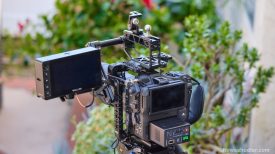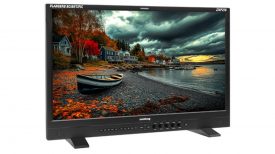By technical editor Matt Allard:
Sony announced a plethora of new cameras and lenses today. None of these were a real surprise – the specs and names of these new arrivals have been known for some time thanks to leaks and rumours – but here’s what was released:
A99 body
RX1 (December release)
NEX-6 body
NEX-VG900 (Release date yet to be determined)
NEX-VG30 (November release)
Sony E-mount 16-50mm f3.5-5.6 OSS power zoom lens
Sony E-mount 35mm f1.8
Sony E-mount 10-18mm f4 OSS
Sony A-mount 300mm f/2.8
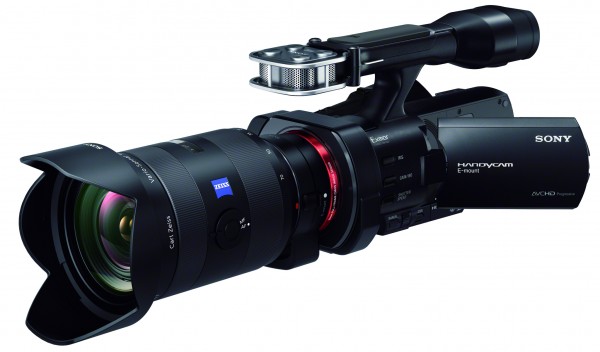
What’s interesting for video shooters?
First, the VG-900. Now, this is an interesting camera, not because I think the image quality that’s going to come out of it will rival established cameras like the F3 or F700, but because of its unique design. The full-frame sensor of the VG900 is identical to the sensor of the Sony A99 (which was also announced today). The VG-900 will be able to record full HD 1080 60p and 24P video and the PAL model of this camera shoots 50P and 25P and 24P.
This is the world’s first full frame dedicated camcorder. Think about this for a second: the sensor is actually larger than that of the Sony flagship F65 cine camera! Before we all go running out to buy one, let’s be realistic. While this sensor is a whopping 24.3MP (The F65 is 20MP), you are still only going to get a 1920×1080 image. And the fact this camera is only $3,299 suggests that the back end processing is not going to be anything like an F65.
Now, this is pure speculation, as I have only seen A99 sample videos released by Sony, but as the VG-900 is basically the A99 in a video body minus a lot of the stills features, it is pretty safe to assume that the two cameras won’t look that much different. (The only major difference is the lack of a SLT mirror in the image path). The camera looks very much like a VG-10 or VG-20 and that form factor is not great for bigger full frame lenses. You may end up with heavy full frame glass on a very light camera and this may make hand-holding difficult. That said, it is no worse than many of the other current camera designs out there. Wedded to a decent rig or tripod it should be fine.
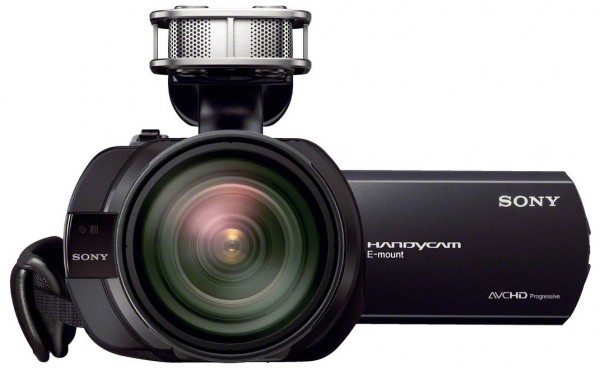
Here is the really interesting thing about this camera: when APS-C glass is used, it will automatically crop down the image to match the APS-C glass while retaining full resolution. This means that unlike most full frame cameras you can use both APS-C and full frame lenses. So if you put, say, a Sony Zeiss 16-35mm full frame lens on this camera, you will be getting 16-35mm. If you put a APS-C lens, say a 24mm, it acts more like a 35mm lens. This is a terrific option and gives you great flexibility by allowing you to achieve super shallow depth of field when using full frame lenses. The VG-900 will also include the new Sony LA-EA3 adapter so that you can use A-mount (and legacy Minolta glass) with the ability to autofocus. The E-mount also has a shallow flange distance which allows many other lenses to be used with an adapter. Metabones offers a great adaptor to allow the use of Canon EF lenses with full electronic control on current NEX cameras – hopefully this can be made to work on the VG-900.
This camera may very well suit news and documentary shooters who are on a budget and want the flexibility of different depth of field looks and the ability to be able to use a zoomable lens as well as stills glass in one package. In addition the VG-900 features autofocus that if similar to other NEX models may prove useful in some situations. That said it is still completely different to using a more traditional video camera such as the recently announced Sony PMW-150.
The VG-900 has another ace up its sleeve. It outputs a full, clean and uncompressed HDMI so you could hook it up to an external recorder such as the Atomos Ninja, Aja KiPro Mini or Sound Device Pix range to record at a higher bit rate. Whether this improves the image is yet to be seen, but it is likely to yield improvements.
Audio-wise, an $800 optional XLR audio module is available and is very similar to the ones used with the Sony NXCAM series – it attaches to the camera’s special Sony shoe mount. While this offers professional XLR inputs with line/mic adjustability, it is crazy not to have it as standard equipment on this camera. (I can understand it not being included on the A99 as that is a stills camera). This takes the price up over $4000US if you want to include professional audio inputs.
The kit lens that is available with the camera is the same one that comes with the NEX EA-50 and is compatible with the FS-700 too. It has a power zoom with a range of 18-200mm at f3.5-6.3 with the ability to zoom the lens with the built-in zoom lever on the VG-900. The lens offers 6 steps of zoom speed control and the body offers an 8 speed zoom rocker. The VG-900 has a full frame sensor that also allows you to also do a 2x digital zoom using this lens. To me, this camera is exciting because it is showing the direction that the more expensive cameras could go in. I would love to see a F3 replacement that utilizes a hybrid system like this and allows a full frame look but also has the ability to crop the image. For news shooters a hybrid 2/3″ Super 35mm sensor would also be fantastic. Having the ability to shoot with ENG zoom lenses and then being able to put Super 35mm glass on for shallow depth of field stuff would be very handy.
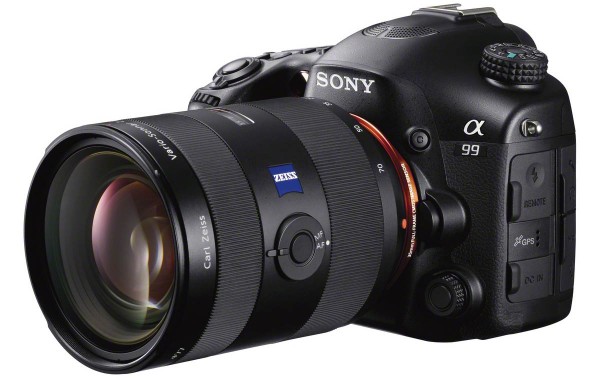
Next up is the new A99:
Sony’s full frame flagship DSLR and the replacement for the A900. The A900 took amazing pictures but had no form of video whatsoever; the A99 is a completely new camera. This should be a lot better in low light than its predecessor, but I have yet to test how this effects the video quality. The ISO only goes up to 6800 in video mode but 25,600 in stills mode. It does have quite a few useful additions for the video shooter including a rear LCD that can rotate around and be moved up and down for easier viewing. This is something I would have really liked on the 5D mkIII. Like most of Sony’s other offerings it records to AVCHD to SD cards. I am only guessing, but I would assume the bitrate is no higher than 28Mb/s. It does, however, offer full, clean 4:2:2 HDMI out, just like the Nikon D800 and Canon’s C100. What the quality looks like going from this camera to an external recorder is again something that is yet to be seen. It also does 24p/30p and 60p at full 1920×1080; something the Canon 5D mkIII can’t do.
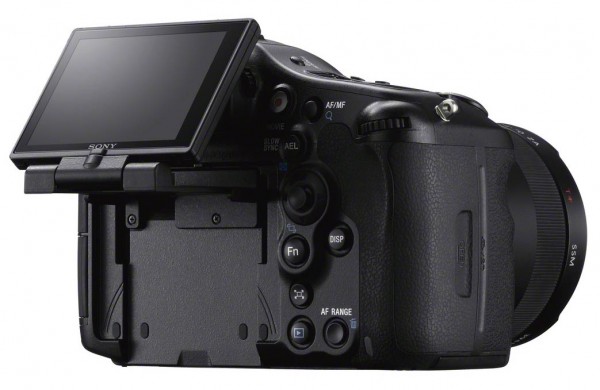
I am assuming that this is a region specific camera as there is no mention of 25 or 50p. For me this would be disappointing. Come on Sony: make it a world camera! You think they might have learnt their lesson after the FS100 (which was originally region limited but later made into a ‘world camera’ via free firmware upgrade). Audio-wise, Sony have an optional XLR audio pack that attaches to a new type of hot shoe connection on the camera so you can run full XLR line/mic audio with full manual control over the audio. This optional unit looks to be almost identical to those that come on a lot of the Sony NXCAM range of cameras. I haven’t seen any mention of whether you can monitor audio or even see levels before or when recording on the A99. However, for the video shooter it’s great news as it allows you to use professional audio equipment with XLR inputs.
As both a stills and a video camera it has very stiff competition from both the Canon 5D mkIII and the Nikon D800. Only time will tell how it compares.
Also launched today:
Sony also launched another new camera which appears similar to the VG-900 – but less exciting. The NEX VG-30 is the successor to the VG-20 and is similar in many ways. The main differences are the power zoom lens as a kit option and the addition of a zoom rocker on the camera’s grip to control it. Instead of having a full frame sensor it will have a APS-C sensor. The VG30 will not come with an Alpha lens adapter as standard, although you can buy an LA-E1 or LA-E2 adapter if you wish.
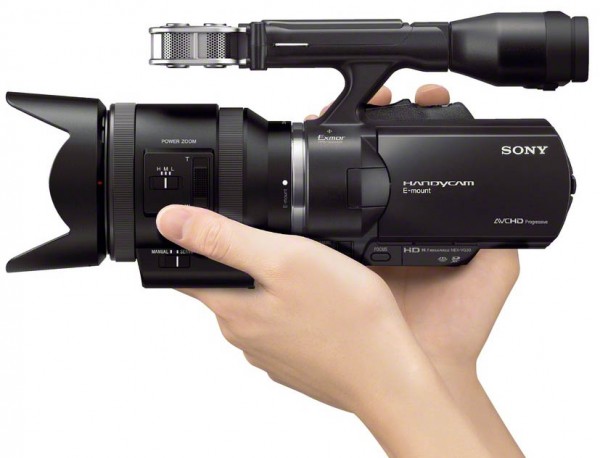
The NEX-VG30H with the 18-200 Power Zoom lems will be offered for $2,699 US and will be available in November. The 18-200mm Power Zoom lens will retail separately for $1,300 so the kit will save you $400 versus buying it separately.
The other two cameras that were launched – not as exciting for the video shooter – are the Sony NEX-6 and the world’s smallest full frame camera, the RX1. The RX1 is a fantastic feat of engineering and you have to hand it to the guys at Sony. The downside for the video shooter is that it has a fixed 35mm lens on it. It really is a niche camera, but it is also another glimpse into the future of what is possible.
The NEX-6 is an new model in-between the NEX5R and NEX7. It takes the same NEX lenses as other models. Possible video uses are as a B-cam or crash cam, as well as a go-everywhere, slightly more compact alternative to the NEX7.
Lens-wise, Sony announced the new Zeiss “Planar T * 50mm f/1.4 ZA SSM Full-frame lens. It’s based on the classic Zeiss lens that exists in different versions like the 50mm Planar for Canon and Nikon. It is expected to ship in Spring 2013 and there is no pricing information yet.
There was also the 16-50mm f3.5-5.6 OSS E mount Lens pancake. When fully retracted, the E16-50mm lens is just 29.9mm, yet covers a wide 16mm to 50mm range (35mm equivalent 24-75mm) for flexible shooting. The lens features one ED (Extra-low Dispersion) and four aspherical elements, resulting in a high-performance lens that is surprisingly portable. The E16-50mm Power Zoom lens with manual override is the first Sony E-mount lens with an electrically driven zoom mechanism. As soon as the camera is turned on, the lens extends and is instantly ready for shooting. The built-in Optical SteadyShot (OSS) image stabilization system provides a 4-stop (approximate) shutter speed advantage, making it significantly easier to achieve crisp, blur-free images and video. This lens could be a very good addition to a VG-30/ VG-900 or FS700.
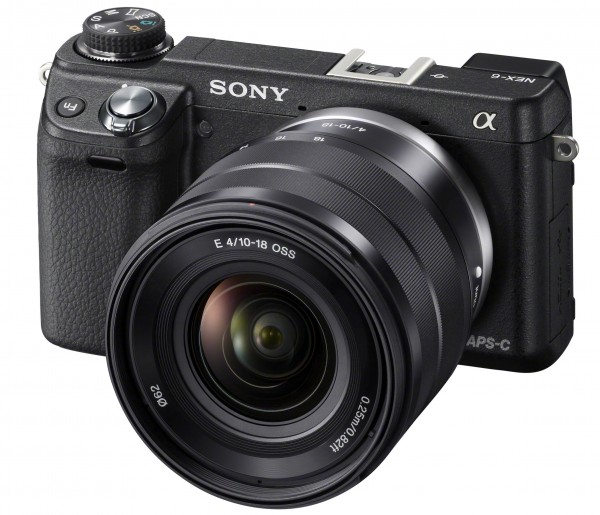
Another announcement was the Sony E10-18mm f4 OSS Lens. This lens is a useful wide angle that for NEX users makes an interesting alternative to the popular combination of a lens adapter and Tokina’s 11-16mm f2.8. It features a Super Sonic Wave motor for quiet responsive autofocus, a lightweight design with detachable tripod mount and special sealing against dust and moisture. It too features the OSS technology. Fitting ND filters should be easier than many wide angles due to it’s smaller size. Depending on how much distortion there is it should make a great lens choice on E mount cameras. The price is expected to be $1200US.
They also announced the Sony E35mm f1.8 OSS Lens which is a cheaper E mount lens at around $650US.
This from Sony on the A99:
24.3MP Exmor Full-Frame CMOS Sensor
The 24.3MP full-frame Exmor CMOS sensor provides a high level of image quality and additional low-light sensitivity benefits. This sensor allows for an extended ISO range from 100 to 25600 while effectively reducing noise at higher sensitivities. This combination of sensitivity and reduced noise make this camera ideal for use for action photography indoors or at night.
Dual Autofocus System
Utilizing the Translucent Mirror technology, the autofocus system is able to continuously monitor the image frame and alter the autofocus quickly and responsively. Two phase contrast sensors, a 19-point sensor above the translucent mirror and a 102-point focal plane phase detection sensor, work together to deliver greatly improved subject tracking performance and increased precision.
Full HD Video Recording
Full HD 1080p recording is supported with this camera and also makes use of the high-speed Translucent Mirror Technology for continuous autofocus, even while using Live View to monitor your shooting. The AVCHD format is used and allows recording of 60 frames per second (60p) for outstanding clarity and motion detail. Additionally, the 24p frame rate is supported allowing you to create movies with a more cinematic feel. For even greater control over video recording, P/A/S/M manual shooting modes, selection of ISO from 100 to 6400, and Picture Effects are available.
Xtra Fine LCD
The rear 3.0″ LCD features Sony’s TruBlack technology for increased clarity and resistance to reflections. It has a 1,228,000-dot resolution for sharp, vivid imagery when reviewing images or monitoring your recording while using Live View. The monitor also features Shot Result Preview, for previewing the effects of your camera’s settings before the exposure is made. For even greater viewing possibilities while shooting, the screen is able to tilt up to 180° vertically and rotate up to 270° horizontally. The range of movements and reflection protection give you a wide variety of possibilities for viewing from difficult angles and lighting conditions.
BIONZ Image Processor
The enhanced BIONZ image processor easily handles the large 14-bit data generated by the full-frame sensor to deliver fast speeds and performance. It offers significantly reduced write times. The increased power afforded by this processor allows increased noise reduction and richly detailed gradations throughout the entire dynamic range.
SteadyShot INSIDE Image Stabilization
This camera features Sony’s SteadyShot technology for image stabilization within the camera. By reducing camera shake at the camera level you can achieve shake compensation up to 2.5-4.5 stops in shutter speed. This technology is compatible with any Sony Alpha lens.
Lens Shading and Aberration Compensation
Depending on the Sony lenses you mount to the A99, the camera will compensate for its unique handling of the images you shoot through it. Shading, or vignetting, caused by the lens will be corrected, and aberrations like ghosting, distortion and chromatic aberration will be compensated for each unique lens attached – providing ideal compatibility from one to the next.
6 Frames per Second Continuous Shooting
Full-frame images can be captured at 6fps with the dual AF system. When using the Tele-zoom High Speed Shooting mode, up to 10fps can be recorded while magnifying the center of your image by 1.46x. This cropping limits your image resolution somewhat and brings your subject closer for tighter compositions.
Tru-Finder OLED Electronic Viewfinder
The Tru-Finder EVF is a high resolution finder featuring a 1,440K-dot resolution, a 100% field of view, and a wide 31.9° viewing angle. It delivers a bright, clear image in almost any lighting conditions, including bright sunlight. This finder displays image information regarding exposure settings and modes, and Shot Result Preview allows you to preview the effects of exposure control, white balance modifications, and other creative modes before making an exposure. You can also review photos and video after you’ve captured it. Adjustable finder magnification gives you the choice between 1.04x and 0.97x, permitting you to see the entire frame while wearing glasses.
Area-Specific Noise Reduction
The noise reduction system used by the A99 divides your images into various parts based on their patterns including edges, textures and gradients. It then processes these areas using the best and most appropriate settings to optimize image quality, and reduce noise. This is all in addition to the conventional noise reduction techniques employed by the camera, and helps to produce images with low noise throughout the wide 9-stop ISO range of 100 to 25600, and expanded to include ISO 50.
Quiet Multi Control Dial
The combination of a button within a smooth twisting dial allows you to adjust photo, video or audio settings without producing audible clicks or vibrations that may be heard while recording. You’ll find this dial built into the front of the camera body, below the lens release button, and is kept right at your fingertips when holding the camera in both hands.
Dirt, Dust and Moisture Protection
The A99 employs comprehensive dust and moisture resistance that contributes to its high reliability and long life. Sony tightly interlocked the camera’s panels and components, added sealing around most of its buttons and dials, and placed gaskets along the edges of the viewfinder and LCDs (both top and rear) in order to help prevent water and dust from entering the body during rough conditions. Jack covers are fitted with rubber-based covers for better sealing and are organized by function in order to minimize unnecessary opening and closing. The front section of the accessory shoe is also constructed of highly dust and water resistant parts.
Sensor Cleaning System
Should dust particles enter the camera when the lens is being changed, two levels of internal protection safeguard the image sensor. The first is a newly developed coating applied to the surface of the optical low-pass filter. This highly effective anti-dust coating effectively suppresses the attachment of both dry and moist dust particles, simplifying their removal. The second level of protection is an anti-dust vibration mechanism that vibrates the filter at high speed every time the camera is switched off in order to dislodge any dust particles that settled on its surface.
1200-Zone Evaluative Metering
An advanced evaluative metering sensor with 1200 zones ensures you capture balanced exposures in a wide range of lighting conditions, as well as accurate subject recognition when tracking subjects. Choose between the available Multi segment, Center weighted and Spot metering modes.
Two-Axis White Balance
Enabling finer white balance adjustment than auto white balance is capable of, you can adjust white balance using amber to blue and green to magenta spectrums in order to achieve more true-to-life color using almost any kind of light source.
Auto HDR
When this mode is selected, three separate bracketed exposures are made at a time and then automatically composited into a single file. This resulting file represents the longest range of tones in highlights, mid-tones, and shadows. Unlike traditional high dynamic range capture, this mode does not require the use of a tripod and simplifies the entire process into a simple, in-camera function.
Auto Portrait Framing
Auto Portrait Framing automatically creates compositions revolving around your portrait subjects and artfully crops your image based on the rule of thirds, where your portrait is located within the frame, exposure on your subject, and the direction he or she is looking. Face Detection, Smile Shutter, and Face Recognition modes are used in conjunction with Auto Portrait Framing for creating the best portraiture possible in a highly efficient manner. This mode utilizes the Clear Image Zoom function and automatically creates a second image file based on these considerations.
Multi Frame NR and Hand-Held Twilight
Similar in theory to an HDR image, Multi Frame NR and Hand-held Twilight feature a noise reduction technology that automatically composites 6 different images into one file for a reduction in noise up to 2 ISO stops. Once you have selected your desired settings, you can create extremely low light images with confidence. The camera combines these 6 exposures to provide a gain in brightness without the increased noise that is associated with higher sensitivity levels. Since the initial exposure length is also shorter, you can easily handhold for shots that are sharp regardless of the ambient lighting.
Built-In GPS for Geotagging
The A99’s built-in GPS feature tags your photos with global positioning data that indicates where and when they were taken, so you don’t have to. When you view tagged photographs on a PC installed with PMB software, or on a connected BRAVIA TV with its Photo Map function, the photos are displayed on a map to indicate where they were taken. A highly sensitive antenna in the camera ensures clear GPS reception wherever your photography takes you.
Picture Effects
A variety of picture effects are supported for in-camera image-processing and creative applications. These effects include HDR Painting, Soft Focus, Miniature, Soft High-key, Pop Color, Partial Color (Red, Green, Blue, Yellow), Rich-tone Monochrome, Toy Camera, High Contrast Monochrome, Posterization (Color), Posterization (Black & White), and Retro Photo. They are available for both photo and video recording.
And this from Sony on the NEX-VG900E (European version) interchangeable lens Full HD camcorder:
Offering supreme imaging quality and generous creative options, it’s the first Handycam® with a 35mm sensor to fully exploit the artistic potential of interchangeable lenses by Sony and Carl Zeiss.
With a resolution of 24.3 effective megapixels, the Sony-developed Exmor CMOS sensor inside the NEX-VG900E is around 40 times larger than the equivalent in ordinary consumer camcorders. It’s also more than twice the size of the APS-C sized sensor found in other interchangeable lens Handycam® models.
As well as permitting beautiful ‘bokeh’ (defocus) effects with the growing range of α lenses, its high sensitivity assures extremely clear, low-noise images. The large sensor size assures effortless reproduction of the finest tonal gradations, helping the most demanding cinematographer fully realise their creative vision.
The sensor also allows the NEX-VG900E to shoot full-frame 24.0 effective megapixel still photos, with all the quality you’d expect from a pro-class DSLR camera. Still images can be shot in RAW format for total post-processing freedom.
Beautiful, film-like results can be achieved by shooting video in 25p/24p progressive mode, with Cinema Tone Gamma™ and Cinema Tone Colour™ offering precise control over cinematic colour grading effects. AVCHD version 2.0 standard 50p recording is additionally supported, maximising the range of creative options for movie-makers to explore. Even greater flexibility is provided by a choice of new Picture Effect modes, enabling easy creation of artistic ‘in-camera’ treatments whether you’re shooting HD video or stills.
Video shooting is further enhanced by a ‘seesaw’ lever that allows smooth, polished zoom control. The lever adjusts optical zoom when using compatible E-mount lenses that feature built-in zoom drive. The lever controls electronic zoom when using the camcorder with fixed focal lenses for impressive creative results.
As an extra refinement, the NEX-VG900E switches automatically from full-frame operation to APS-C mode when an E-mount or A-mount DT lens is attached. This allows users to get the most out of their collection of DT lenses that are optimised for cameras with a smaller APS-C image sensor.
The camcorder also comes supplied with the LA-EA3 adaptor that lets photographers use full-frame A-mount DSLR lenses at their designated focal length.
There’s a generous palette of control options and manual settings to satisfy the demanding video enthusiast. Aperture priority, shutter speed priority or manual exposure, are all selectable and white balance can be adjusted manually to suit the demands of any scene. Iris, shutter speed, and gain adjustments can be easily made via logically-positioned direct access keys. Accurate manual focusing is assisted by the camcorder’s pro-style display peaking function, complemented by a one-touch focus magnification button on the top of the grip.
Serious videographers will welcome the detail-packed XGA OLED Tru-Finder that offers high-contrast image monitoring with superbly natural colour rendition. Complementing the Tru-Finder, there’s an adjustable XtraFine touch-panel LCD monitor, with Sony’s unique technology for high contrast images with rich, deep blacks.
High-quality audio is a crucial part of the HD video experience with the NEX-VG900E. A unique Quad Capsule Spatial Array Microphone features four omnidirectional capsules that can be switched for stereo or 5.1ch surround recording. Recording levels are adjustable, with accurate visual confirmation provided by an audio level meter on the LCD display. There’s also a headphone jack for direct monitoring of sounds being recorded.
The new Multi Interface Shoe provides compatibility with accessories including the optional XLR-K1M adaptor kit that adds a high-quality mono shotgun mic and pro-standard XLR connections.
And this on the NEX-VG30:
Sharing many of the pro-oriented enhancements of the NEX-VG900E, the Handycam® NEX-VG30E succeeds the acclaimed NEX-VG20E. With a resolution of 16.1 effective megapixels, the new camcorder’s Exmor™ APS HD CMOS sensor assures outstanding image quality with the range of interchangeable E-mount lenses.
Like the NEX-VG900E, it’s possible to shoot smooth, cinematic Full HD video footage at either 50p, 25p or 24p (progressive) frame rates, supported by a palette of artistic Picture Effect modes.
The NEX-VG30E also features the same XGA OLED Tru-Finder, comprehensive manual controls and ‘seesaw’ style zoom lever as the NEX-VG900E.
The NEX-GV30EH comes supplied as a kit with the new E PZ 18-200mm F3.5-6.3 OSS Power Zoom lens that provides a versatile range from wide angle to telephoto. Offering smooth, quiet AF operation and Optical SteadyShot image stabilisation, the lens also features an additional ‘seesaw’ lever on the barrel for smooth, professional-style zoom control with adjustable speeds.
The Handycam® NEX-VG900E and NEX-VG30E camcorders from Sony are available in Europe from November and December respectively.
About Matthew Allard, Aljazeera Senior Field Cameraman, Kuala Lumpur:
Matt has been a Camera/Editor in TV news for more 20 years, previously working for both Channel 9 and Channel 10 in Australia. Twice Network Ten Australia’s cameraman of the year as well as being a Walkley Finalist for outstanding camerawork in 2006 (for coverage of the Cronulla Race Riots) and a Logie Finalist for outstanding news coverage 2006 (Bali 9). He is a multiple ACS (Australian Cinematographers Society) award winner. His Sword Maker story that was shot on a 7D won the prestigious Neil Davis International News Golden Tripod at the 2011 ACS Awards. He has covered news events in more than 35 countries, from major sporting events to terrorist bombings. Based out of the Kuala Lumpur broadcast centre in Malaysia he is an avid user and follower of new technology, shooting stories on HD broadcast cameras, the Sony F3 as well as new Canon DSLRs.




